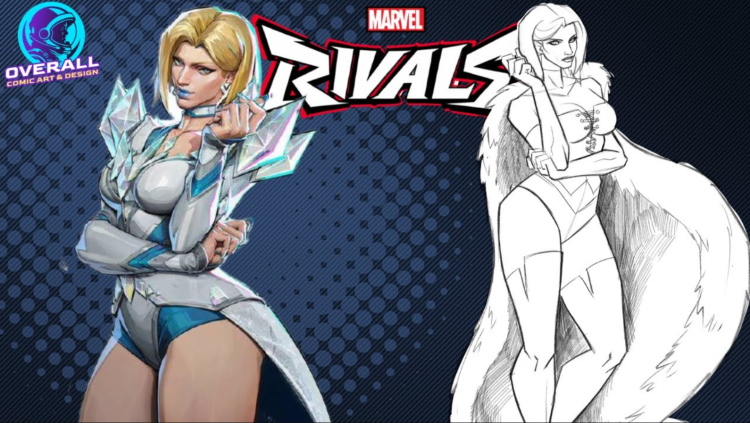Marvel Rivals’ Gooner Game Style Comes Straight from Classic Comics
Marvel Rivals has stirred conversation for its bold character designs and the “gooner game” reputation it has earned over recent updates. Creative director Guangyun Chen has addressed this head-on, insisting that the provocative visuals aren’t just fan service—they’re carefully rooted in classic comic book designs. The game’s swimsuit skins, exaggerated proportions, and playful animations are all inspired by iconic comic moments, with modern twists to suit seasonal storylines and player expectations.
Chen spoke about the game’s style in an interview with the Rivals Assembled YouTube channel. He said that the team deliberately draws on comic history, taking outfits and character looks from memorable comic arcs and reimagining them for the game. Characters like Mantis and Psylocke, for instance, received designs that reflect their original comic appearances while introducing fashionable updates to resonate with modern players.
"These all come from classic comic designs," Chen explained. "We take those classic comic designs and create some more fashionable designs based on them, to gain players’ appreciation."
This approach situates Marvel Rivals within a long tradition of superhero comics where characters’ looks often emphasized exaggerated physiques and stylized outfits. In the early 1990s, Marvel published annual “swimsuit specials,” featuring characters in revealing attire and dramatic poses. While some players see the game’s style as fan service, Chen frames it as a homage to those historic designs. The game’s recent updates, including swimsuit skins for several characters, intentionally recall that era while giving players new options to engage with their favorite heroes.

The seasonal event skins further highlight the game’s storytelling goals. For example, the Krakoa Resort skin for Squirrel Girl combines in-game narrative elements with real-world summer fashion cues. Chen explained that each seasonal design is developed with both story and culture in mind, integrating elements from the game’s ongoing plotlines and popular trends. These skins aim to feel like natural extensions of the characters, rather than isolated cosmetic gimmicks.
Marvel Rivals’ reputation as a “gooner game” isn’t limited to female characters. Male heroes have also received exaggerated visual updates, resulting in the tongue-in-cheek description of them being “caked up.” Venom, for instance, now has an in-game twerking animation that underscores the game’s playful, over-the-top aesthetic. These choices demonstrate that the developers are willing to push boundaries for both male and female characters, embracing a style that blends comic authenticity with humor and spectacle.

The result is a roster where exaggerated anatomy and stylized presentation are central to the game’s visual identity. Emma Frost’s design, for instance, highlights her legs and overall silhouette in a way that even longtime comic fans might find extreme. This reflects the broader comic tradition of larger-than-life character proportions but pushes it further, creating a distinctive look for Marvel Rivals that stands out among hero shooters.
Marvel Rivals also revisits some of the most notorious comic tropes, like Punisher in a speedo. These designs are deliberately cheeky, blending nostalgia with a modern interpretation of classic comics. Chen’s team clearly understands how these visuals resonate with players: they spark discussion, draw attention, and keep the game culturally relevant while still connecting back to the comic source material.
By framing the provocative designs as authentic comic homage, Chen offers a corporate-friendly response that doesn’t dismiss fan concerns while explaining the creative rationale. Players and critics may still debate whether these designs are primarily fan service, but the intent, according to Chen, is to celebrate comic history while creating stylish, narrative-driven skins.
This design philosophy also highlights Marvel Rivals’ unique position in the hero shooter market. Other games, such as Overwatch, have faced scrutiny over overly sexualized designs and have made adjustments in response to community feedback. Marvel Rivals, on the other hand, leans fully into its bold style, embracing both nostalgia and modern player expectations to create a game identity that is unmistakably its own.
The combination of comic fidelity, seasonal storytelling, and exaggerated visuals ensures that Marvel Rivals remains a talking point among players and media alike. The “gooner game” label, while humorous, has effectively become part of the game’s brand, drawing attention without undermining gameplay or story. The developers’ commitment to balancing authenticity with entertainment guarantees that each new skin or animation will continue to provoke discussion and engagement.
While some may view these designs as purely provocative, the connection to classic comics provides a layer of historical context. The swimsuit skins, exaggerated anatomy, and playful animations mirror an era when comics regularly explored the extremes of character design. Marvel Rivals has taken these elements, reinterpreted them for modern audiences, and made them central to the game experience.
Ultimately, Marvel Rivals’ “gooner game” identity is both intentional and strategic. It taps into decades of comic book history while providing visually striking content that draws players in. Chen’s explanations reinforce that the choices are rooted in authenticity, even as the resulting visuals are bold, playful, and sometimes extreme. The game celebrates the comic medium’s flamboyance while blending it with seasonal narrative elements and cultural trends, creating a game that’s as much about style as it is about action.
Marvel Rivals continues to stand out among hero shooters for this reason. Its visual identity, characterized by exaggerated proportions, provocative skins, and playful animations, demonstrates that the developers understand the appeal of combining comic book homage with modern gameplay expectations. By leaning into its “gooner game” reputation, Marvel Rivals has created a space where comic authenticity and fan engagement meet, ensuring that both longtime fans and new players have reasons to explore the game’s roster.
In the end, Marvel Rivals’ bold approach to character design is a reminder that the world of comics—and the games that adapt them—has always embraced the extreme. Chen’s defense of the game’s style underscores that this is a conscious creative choice, one that celebrates comic history, engages players, and keeps the game visually and culturally relevant.

Comments